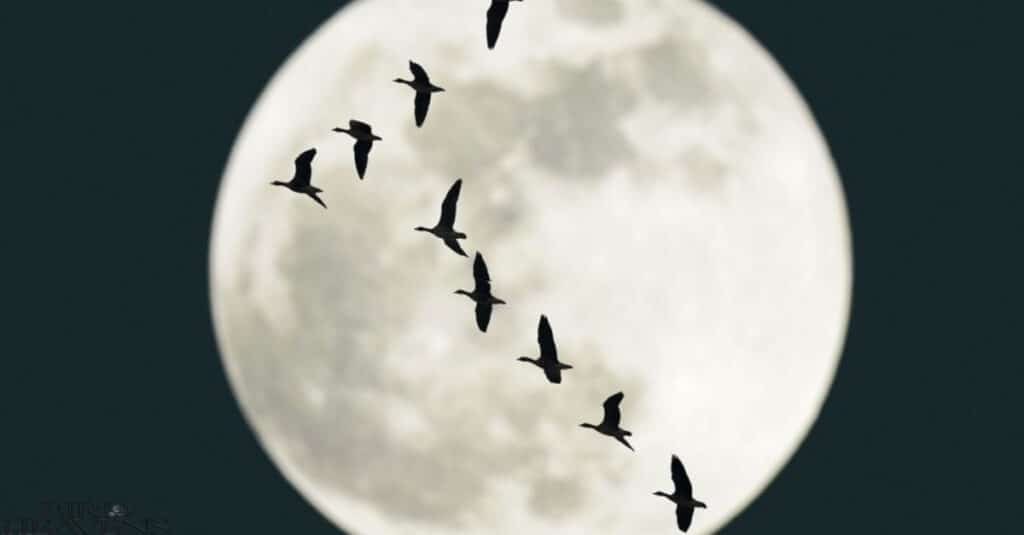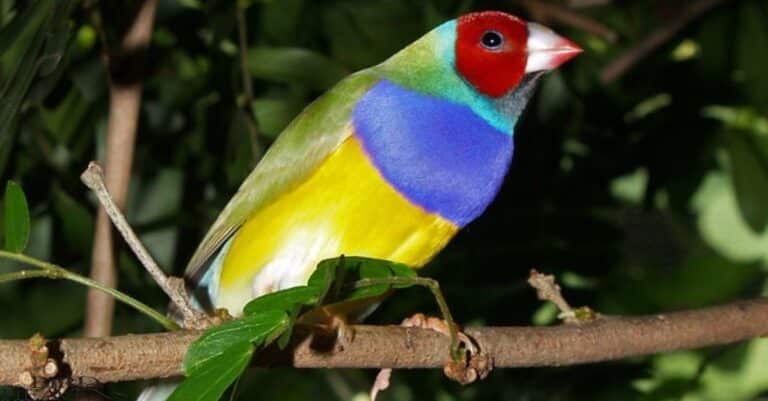Do Geese Fly At Night? How Can They See?
Yes, geese do fly at night. Many species, especially during migration, engage in nighttime flight. They’ve adapted to navigate in low light using stars, the moon, and Earth’s magnetic field.
Night flying offers benefits like cooler air, fewer predators, and less air traffic. However, not all geese fly at night equally, and they face challenges like artificial obstacles and disorienting city lights.
Geese’s Night-time Adventures:
When the sun goes down, you might think all birds settle in for a good night’s sleep. But for many geese, nightfall can signal the start of an exciting journey. Geese fly at night more often than you might expect, especially during their long migratory trips.
Can geese fly at night?
Yes, geese can and do fly at night. While they’re not strictly nocturnal birds, many species of geese have adapted to nighttime flight. This ability allows them to take advantage of cooler air and calmer winds, making their long journeys more efficient.
Are they active after dark?
Geese are primarily diurnal by nature, meaning they’re most active during daylight hours. However, when it comes to migration or long-distance travel, they often switch to a more flexible schedule. This adaptability allows them to make the most of favorable flying conditions, regardless of the time of day.
Why Geese Choose Night Flights:
There are several good reasons why geese might opt for nighttime travel. Let’s look at some of the main benefits of flying geese taking to the skies after dark.

1.Cooler air makes flying easier
One of the biggest night flight perks is the cooler air temperature. Cool air is denser than warm air, which provides more lift for the geese’s wings. This makes flying less tiring, allowing geese to cover longer distances with less effort.
2.Less air traffic from other birds
Nighttime skies are generally less crowded. With fewer birds in the air, geese can fly more freely without worrying about collisions or competition for air space. This night travel efficiency can help them make better time on their journeys.
3.Avoiding daytime predators
Predator avoidance is another key reason for nocturnal migration. Many of the geese’s natural predators, such as eagles and hawks, are active during the day. By flying at night, geese can reduce their risk of becoming a meal for these sharp-eyed hunters.
Geese’s Amazing Night Vision:
For geese night vision to work effectively in low light conditions, these birds have some special adaptations. Their eyesight is crucial for safe nighttime navigation.
How well can geese see in the dark?
Geese have excellent night visibility, though it’s not quite as good as true nocturnal animals like owls. Their eyes are designed to gather as much light as possible, allowing them to see well in dim conditions.
Special eye features for low-light vision
Geese eyes have a few tricks up their sleeves (or should we say, behind their eyelids?):
- Large pupils: These let in more light.
- More rod cells: These light-sensitive cells help with night vision.
- Reflective layer: This bounces light back through the retina for a second chance at detection.
These features combine to give geese impressive vision in the dark, allowing them to spot landmarks and avoid obstacles during their night flights.
Geese’s Navigating in the Dark:
Geese don’t just rely on their eyesight to find their way at night. They have several tools in their navigation toolkit.

1.Using stars and moon for direction
Like ancient sailors, geese can navigate using stars. They use the positions of stars and the moon to orient themselves during their nighttime journeys. This stellar navigation helps them maintain their course over long distances.
2.Earth’s magnetic field as a guide
Geese, like many migratory birds, can sense the Earth’s magnetic field. This ability acts like an internal compass, helping them determine which way is north. It’s especially useful on cloudy nights when stars aren’t visible.
3.Remembering landmarks
Geese have excellent memories and can recognize familiar landmarks even in low light. Rivers, mountains, and coastlines serve as signposts on their migratory routes.
You Might Like >>How Long Do Quail Live
Geese’s Night Migration Habits:
Nocturnal migration is a common strategy for many bird species, including geese. Let’s explore how geese use nighttime travel during their seasonal journeys.
Do geese prefer to migrate at night?
While geese don’t exclusively migrate at night, many species do prefer nighttime travel for long-distance flights. This preference can vary depending on factors like weather conditions, the length of the journey, and the specific species of goose.
Differences between day and night migration
| Day Migration | Night Migration |
| Better visibility | Cooler temperatures |
| Easier to find food | Less predator activity |
| Can use thermal currents | Calmer air conditions |
| More time for rest stops | Less competition for airspace |
Challenges of Geese’s Night-time Flying:
While there are many benefits to flying at night, geese also face some unique challenges during their nocturnal journeys.
1.Dealing with bad weather
Bad weather can be especially dangerous for flying geese at night. Rain, fog, or strong winds can make navigation difficult and increase the risk of accidents. Geese must be extra cautious and may need to land if conditions become too hazardous.
2.Avoiding Aritificial obstacles
Human structures like buildings, power lines, and wind turbines pose significant risks to geese during night travel. These obstacles can be hard to see in the dark, making collisions a real danger. Geese must rely on their memory of safe routes and their ability to detect obstacles to avoid these hazards.
You Might Like >>Small Black Bird With White Belly
Not All Geese Are Night Owls:
While many geese species engage in nighttime flight, not all geese have the same habits when it comes to night flying.

Which goose species fly at night more often?
Some goose species known for their nocturnal flying habits include:
- Canada Geese
- Snow Geese
- Brant Geese
- Greater White-fronted Geese
These species often engage in long-distance migrations and are more likely to be heard honking overhead at night.
Daytime vs. nighttime flying preferences
Some geese species prefer to stick to more diurnal behavior, flying mainly during daylight hours. Factors that influence this preference include:
- Habitat type
- Food availability
- Predator presence
- Length of migratory route
Note : It’s important to remember that even within a species, individual flocks might have different preferences based on their specific circumstances.
You Might Like >>Finches In Texas
Resting and Sleeping Patterns of Geese:
Even with their impressive night flying abilities, geese still need rest. Let’s look at how they balance sleep with their nighttime activities.

When and where geese sleep
Geese typically sleep at night when they’re not migrating. They often rest on water, which provides safety from land predators. During migration, they may take short naps while flying or during brief stops.
They often choose to rest on water, which provides safety from land predators. This behavior is known as “roosting.” Here’s what you need to know about geese sleep patterns:
- Water bodies travel: Geese prefer to sleep on lakes, ponds, and other open water sources. These waterfowl resting spots offer protection from most ground-based threats.
- Group sleeping: Geese often sleep in large groups, with some birds acting as sentinels to watch for danger.
- Sleep duration: When not migrating, geese may sleep for 8-12 hours at night.
- Daytime naps: During the day, geese might take short naps between feeding sessions.
How they balance rest and night flights
During long migrations, geese use some fascinating techniques to balance rest and flight:
- Unihemispheric slow-wave sleep:During long migrations, geese use a technique called unihemispheric slow-wave sleep. This allows them to rest half their brain at a time, keeping one eye open to watch for danger. It’s an impressive adaptation that lets them rest while still staying alert during their night journey.
- In-flight micro-naps: Geese can take very short naps while flying, lasting just a few seconds. These brief rest periods help them stay refreshed during long flights.
- Altitude adjustments: Flying at higher altitudes where the air is smoother allows geese to rest more easily while in flight.
- Taking turns: In V-formation flights, geese take turns being at the front, where flying is most difficult. This rotation allows each bird to have periods of easier flight where they can rest more.
- Strategic stopovers: During long migrations, geese make planned stops at familiar resting areas. These travel destinations allow them to get more substantial rest and refuel before continuing their journey.
You Might Like >>Do Hawks Hunt At Night
The Impact of City Lights On Geese :
As human populations grow, so does the amount of artificial light in our night skies. This can have significant effects on geese’s nighttime navigation.
How artificial light affects night flying
City lights can both help and hinder geese during their nocturnal flights:
- Pros: Lights can help geese see obstacles and landmarks more clearly.
- Cons: Bright lights can disorient geese, causing them to veer off course or collide with buildings.
Changes in goose behavior near cities
Researchers have noticed that geese often fly higher when passing over cities, possibly to avoid the confusing effects of artificial light. Some geese have even adapted to urban environments, using city parks and ponds as stopover points during their migratory journeys.
Listening for Night Flyers:
One of the most distinctive features of flying geese is their honking calls. These vocalizations play an important role in their nighttime travels.
Recognizing goose calls in the dark
Different species of geese have unique calls, but most make a distinctive honking sound. Learning to recognize these goose sounds can help you identify night-flying geese even when you can’t see them.
Why geese honk during night flights
Geese honk for several reasons during their nocturnal migrations:
- To maintain flock cohesion
- To communicate about direction and speed
- To warn about potential dangers
- To encourage tired flock members
These flying honks help the flock stay together and navigate safely through the night sky.
You Might Like >>Owls In Michigan
Conclusion:
Geese’s ability to fly at night showcases their remarkable adaptability. These birds have evolved impressive night vision and navigation skills, allowing them to take advantage of cooler air, avoid predators, and travel efficiently during their long migratory journeys.
While not all geese species fly at night equally, many have mastered the art of nocturnal migration. As we’ve learned, their nighttime habits are complex, influenced by factors like weather, artificial light, and the need for rest.
Understanding these nocturnal behaviors not only deepens our appreciation for these amazing birds but also highlights the importance of preserving dark skies and safe migration routes for their continued survival.

Andrew Paul is a renowned ornithologist and founder of Bird Heavens. With my extensive expertise in bird behavior and habitat preservation,I will insightful content on species identification and conservation.My Future plans include interactive workshops and online courses to foster a global community of bird enthusiasts committed to conservation and appreciating avian life. Join me at Bird Heavens







